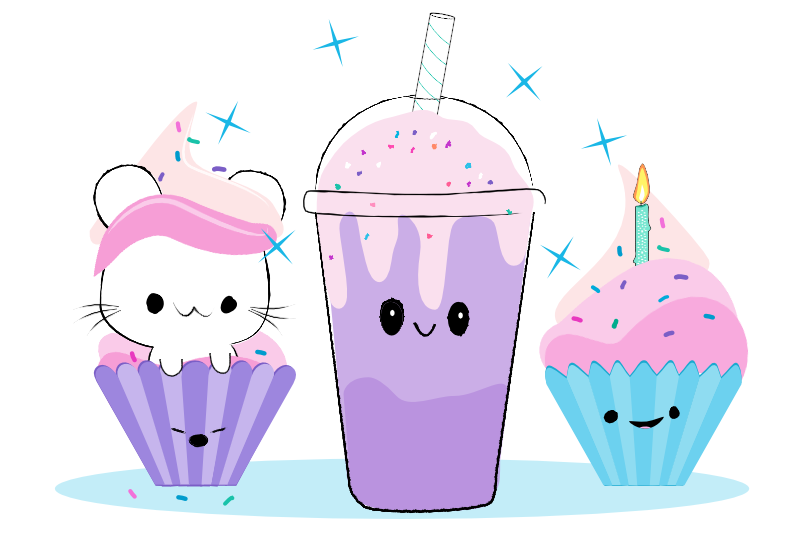Exploring Kawaii Art - The Basics

You see Kawaii art all around you. Who hasn't heard of Hello Kiddy by Sanrio. In the next few tutorials, we will explore how to draw Kawaii art.
Avoid too mush realism. Use only what you need to tell the story.
Most Kawaii art is drawn using simple lines and shapes, flat colors and no sharp edges.
Sanrio Website
https://www.sanrio.com/collections/all-sanrio-characters
Avoid too mush realism. Use only what you need to tell the story.
Most Kawaii art is drawn using simple lines and shapes, flat colors and no sharp edges.
The Kawaii Face
- The Kawaii face is the easiest way to make any design cute and cuddly. In Kawaii art, you can put a face on almost anything.
- Most Kawaii characters have their facial details close together and towards the center of the face. If your character has a nose, you will want the eyes and nose to be almost on the same horizontal line across the face.
- For the eyes, an overly small or overly large dark dot or ellipse will do just fine. Adding a tiny white dot for the reflection is all that is needed. The white dot will show the direction of site.
- The eyes are always important when showing emotion. Closed eyes can be drawn using just a semi-circle, with the curve pointing up. Add a big smile and you've got a very happy Kawaii.
- On the other hand, for a sad or angry Kawaii, turn the smile upside down to a frown. Then add a "V", with slightly bent sides and turned on its side, for each eye.
- Although ears and noses are sometimes omitted for a Kawaii, they can often be an important part of the design. For example, ears and noses are important when drawing animal Kawaiis, such as the very distinctive nose of a pig. Besides indicating the type of animal character, the ears can also be used to show expression or what the animal is thinking.
Color Palette, Flat Colors and Simple Textures
- Kawaii means "cute" in Japanese. One way to make your Kawaiis cute and fun is to use soft pastels and/or bright colors in your color palette. This is easy to do if your design app has the PANTONE Library of color palettes, sometimes referred to as Color Books. Both Adobe and Affinity Apps have PANTONE color swatches. I really like the PANTONE Pastels & Noens Uncoated Library.
- When trying to simplify your design details, using flat colors really helps. Flat color, also called block color, refers to solid, one color areas in a design. That's why you see very few Kawaii designs with gradients or halftones, unless it is very important to the design.
- Adding a little texture to your character can add interest to your design. Some simple ways to add texture is to add a few tiny dots on the face to represent whiskers on an animal Kawaii or adding a few simple lines on a human character's head to represent hair. But remember the "less is more" rule when adding texture.
Body Proportions and Asymmetry
- Another characteristic of cuteness is exaggerated body proportions, especially a large head on a small body. That is why babies and animals are so cute. Again, this is where "cute" trumps "realism" in Kawaii art.
- Another tip is to forget about using the "duplicate and flip" technique when drawing both sides of the Kawaii. For example, it can be tempting to draw one eye on the face and then duplicate that eye for the other side of the face. This will make your character dull. Adding different details two each side of the character will give your Kawaii personality.
Rounded Corners and No Perfect Shapes
Following along with the cute and cuddly theme, you won't find many sharp corners or perfect geometric shapes in Kawaii art. If you use the basic Shape tools in Affinity Designer to draw your Kawaiis, don't forget to reshaped those perfect triangle shaped ears and oval shaped head, by tweaking the individual anchor points on the shapes.Sanrio Website
https://www.sanrio.com/collections/all-sanrio-characters

Related Articles
Editor's Picks Articles
Top Ten Articles
Previous Features
Site Map
Content copyright © 2023 by Diane Cipollo. All rights reserved.
This content was written by Diane Cipollo. If you wish to use this content in any manner, you need written permission. Contact Diane Cipollo for details.







